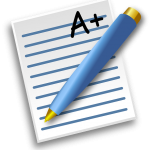AT A GLANCE
●Select an abstract noun that represents a value you believe in (or wish to expose as destructive).
You will define every possible facet, using at least 20 abstract properties (sub-definitions) of the
word as your main points. You will include definitions you do not believe, and you will include
contradictory definitions that, seemingly, could not all be true.
●Diagram/listing must be turned in (multiple file upload options available).
●Thesis and Outline should refer to the central definition of your selected term, as well as
the categories of sub-definitions that relate back to the core essence of the value. Concrete
illustrations will be used to bring the abstract concepts to the mind’s eye of your audience, and
will be subordinate points.
●Purpose: To Define. (You may add other purposes if you choose: to entertain, to persuade, etc.).
●Audience: Teachers and students who are interested in definition for its own sake, and are
predisposed to enjoy your paper immensely.
●Voice should be confident, authentic, and appropriate to your task. It need not be strictly
formal (may use first person and contractions), but should be appropriate to its academic setting.
●Paper is 2-3 pages long. Include an informal cover page illustration that represents the core
definition of your word. Before you turn the paper in, highlight your thesis statement, if you
use it in your paper.
●Use MLA 8 for format and show attribution for sources by attempting MLA citation. Keep
records for all sources used, as you will cite them formally upon revision.
●Process must be turned in and include required steps culminating in a rough draft, wild draft
(may be handwritten), workshop draft (must be typed), peer review workshop, and final draft
(must be typed). May revise again for higher grade.
Preparation
–Begin by listing 15 possible concepts that you might be interested in writing about—post list
onto discussion board and read through other people’s ideas—ask each other questions if you
want to, and I will chime in, too.
–The term concept refers to an idea, value, or principle. We use concepts to identify or
organize our experiences. According to the American Heritage Dictionary, a concept is “A
general idea derived or inferred from specific instances or occurrences; something formed in the
mind; a thought or notion.”
–Think of the concept as one word that you will define in depth and breadth—it will be an
abstract noun. You will define this term in the abstract, using concrete illustrations in a
subordinate way.
2
–Some common, big-picture concepts like “integrity,” “justice,” or “morality” might come to
mind quickly, but consider less obvious concepts as well, such as “reality” or “style.”
–Try to choose a positive value or principle that you take seriously. Alternately, you might
deliberately choose a negative value (such as “hypocrisy”) that you wish to expose as a violation
of a sincerely held value. You could also define two values that overlap or work at cross
purposes, though this would be twice as much work.
–For pre-writing, write down what you already know about your concept.
Look it up in the dictionary.
Ask friends and family what they think it is.
Search Quoteland.com or similar sites to quickly get impressions about how your word is used
in the world and in the imagination. Then think about how your concept functions in reality and
examine contradictory, paradoxical, and mutually exclusive definitions.
Visual Thesaurus online might be interesting to you.
Consult specialty dictionaries in the reference section of the library or online, including The
Stanford Encyclopedia of Philosophy http://plato.stanford.edu/
Google your word and consult urbandictionary.com and slang dictionaries.
Make this inquiry your status update on Facebook and collect the comments.
Look at archaic definitions in old dictionaries, and, of course, the Oxford. Black’s Law might
be eye-opening as well.
–Do an image search online.
–Try to imagine the view that your audience might already hold about your concept and endeavor
to both mirror and disrupt existing perspectives.
–You may be applying this concept to a concrete issue in another paper.
Requirements
–You are writing this paper based on your ideas and opinions as well as every other
perspective you can possibly imagine, discover, or infer. You may do this with or without
research, but sources will probably help push your imagination. Include contradictory ideas and
unusual definitions. Include at least 20 properties (abstract definitions) which are illustrated (with
concrete image that can be seen in the mind’s eye) and held together by a central property or
“essence” of the concept. Be sure to include definitions that you don’t agree with.
–If you use sources, cite them using the MLA guidelines or attribute sources in any way that
you are able (this won’t be evaluated because we haven’t covered it yet).
3
–Keep all notes, prewriting, drafts, outlining and false starts in your portfolio. You must include
class notes, group work, and a visual illustration of your ideas–I will ask you to turn in your
diagram and provisional thesis at least once before Talking Draft.
–This paper is 2-3 pages long. For format, see Purdue OWL MLA paper format.
–Choose a one word “concept” and define.
–Identify the properties of your chosen concept. What qualities and connotations come to
mind? How does it operate in the world? What is the concept’s history and likely future? How
can you illustrate it in such a way that brings these ideas into our minds’ eyes?
–Your thesis should include the “essence” of your definition, and list the broad categories that
frame the definition. In this way, your thesis should still include the claim (central definition) and
support summary (categories of definition). For example: “Power is force, manifested: it has both
honorable and evil qualities, and is divisible into categories such as political, mechanical,
spiritual, personal, and natural power.”
–Your purpose is to define.
–Your audience is an academic audience—students and teachers who are already interested in
ideas for their own sake. They are predisposed to be interested in and enjoy your paper.
–Your writing voice (style and tone built upon word choice) should be semi-formal—invite a
spirited dialogue with your curious and engaged audience.
–The organization of the paper should include the following:
Introduction You will need to give the reader some indication as to what the subject
matter of you essay will be. You will be defining a concept in all its glory. Do this in an
inviting way.
Body Take your reader step by step through your process of exploration. It might be
helpful to start with a central definition of your concept, or you might reserve it until the
end, in order to use it as a conclusion that is drawn. Show the properties, how it operates
in the real world, and illustrate or give examples (that are not related to “resource”
issues). Though you may draw conclusions if you wish, this is not required. The claim
and support summary must define using the structure set out in this assignment.
Here’s a simple way to organize your main points (to see this outline in action, analyze
“Definition of Soul” in this week’s reading):
I. Property #1
A. Illustration
II. Property #2
A. Illustration
Closing Do not summarize. Instead, remind the reader why this definition is relevant or
interesting. And, of course, leave your reader with something interesting to think about.
4
–Behind the final draft of your paper, attach all drafting materials as outlined in the
Portfolio Table of Contents.
Suggestions
–Ask yourself this question: Am I showing as many possible facets (a minimum of 20
properties/sub-definitions) of the concept as I can in 2-3 pages? Be Concise—Say as much as you
can using as few words as possible.
–Choose a concept that truly interests you. Think about how it might connect to future papers,
but don’t try to write ahead. Choose an all-purpose concept that you believe in.
–In the course of defining your concept, you might consider some or all of the following
strategies as methods of explanation:
1. Classify the properties of the concept. For instance, the concept of power has multiple
meaning that can be put into categories: political power, mechanical power, personal
power, spiritual power, natural power, community power, and physical power.
Distinguish your ideas from other ideas. If you see military and political power as
essentially the same thing, put them into one category. If you see them as essentially
different, divide them into two. Then, break these categories down into nuanced sub-
definitions. For instance, personal power might include the abstract qualities of
stubbornness, fearlessness, calm, and drive.
2. Compare categories. For example, political power and personal power may overlap, but
they have clear differences as well. You might compare several areas or look at just two.
For example, you might define only two properties of power as “power over” and “power
from within.” How are these alike? How are they different? What ten properties are
contained within each? contained within each?
3. Find analogies. Show how the idea you are explaining is like something else that you
audience might be able to understand more readily. For example, “All power is like water
in the wild.”
4. Work with opposites. Power is “good” signals its own call for sub-definition—which
properties are good? How-so? Under what conditions? Power is “bad” also has plenty of
room for expansion. Include definitions that can’t both/all be true at all times. What ten
properties are contained within each of these opposite categories?
5. Be on the look-out for your central, or core, definition—the “essence” of the word. All
the other properties should have some relationship to this one. For example, “Power
makes things happen,” or “Power is force, manifested,” or “Power is formidable ability.”
–Think for yourself.
–Use your imagination. Make you topic more interesting than it would appear to be.
–Use the personality and authority of your writing voice to be persuasive.
–If you have questions, please email me or stop by my office to visit.


